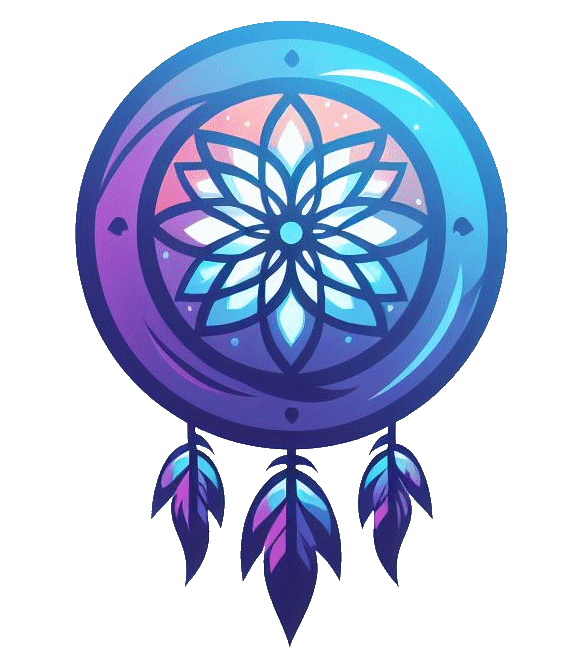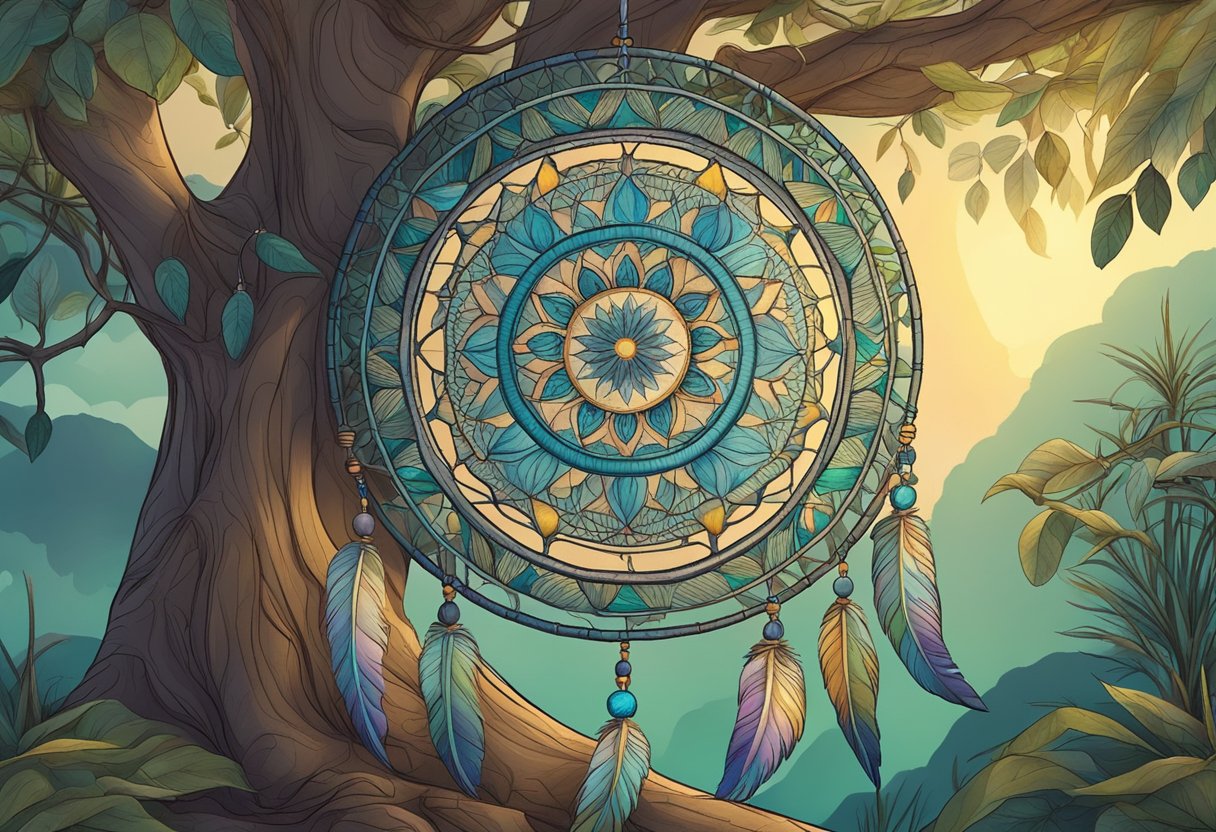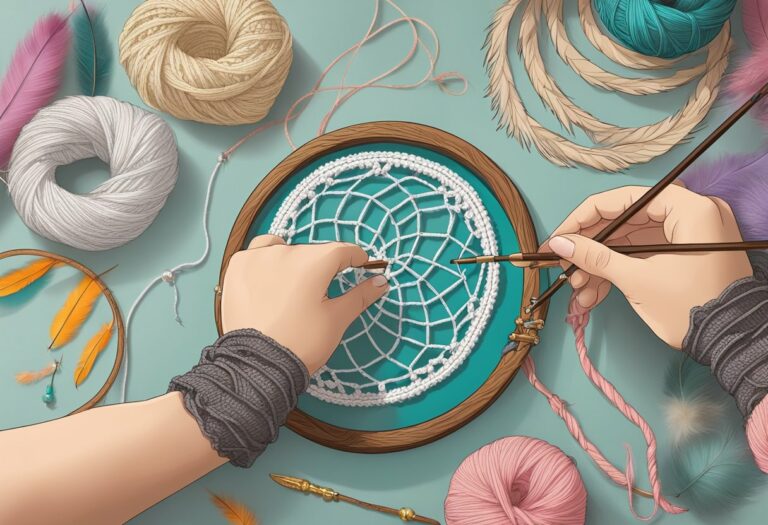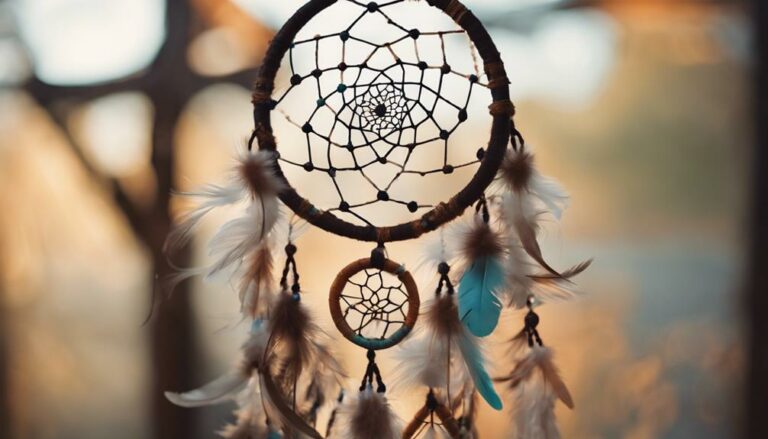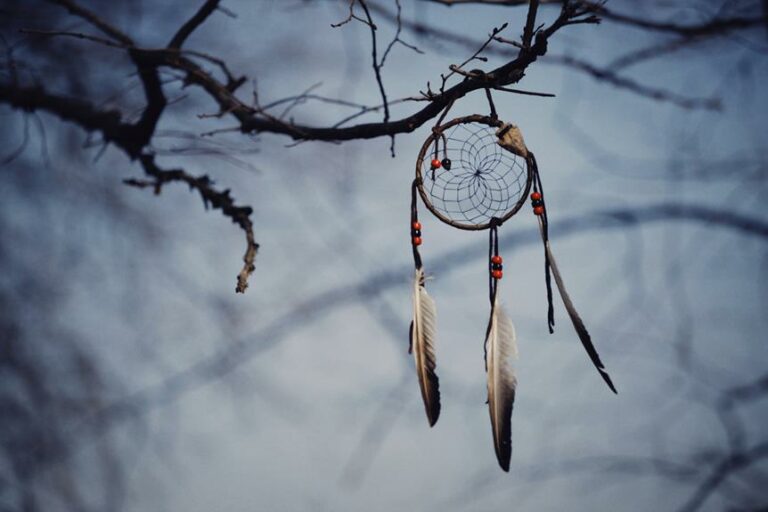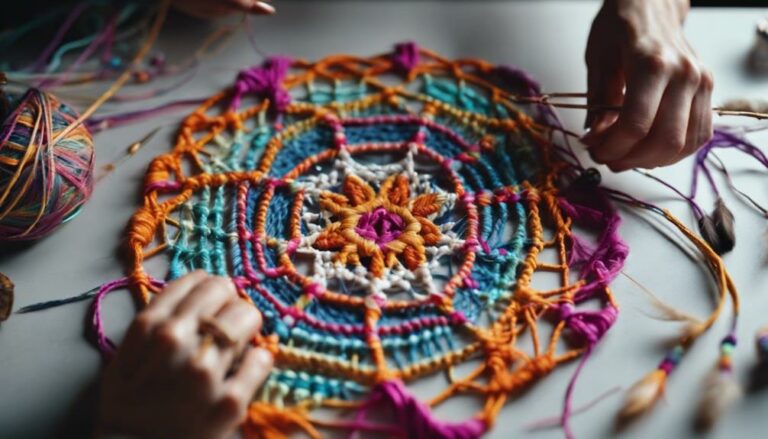Difference Between Dreamcatcher and Mandala: A Clear Guide
Dreamcatchers and mandalas are both intricate and beautiful designs that have been used for spiritual and decorative purposes for centuries. While they may look similar at first glance, there are distinct differences between the two. Understanding these differences can help you appreciate the unique symbolism and meaning behind each design.

Dreamcatchers are a Native American creation, traditionally made by the Ojibwe people. They are typically made from a hoop of willow wood, with a web of sinew or string woven inside. The dreamcatcher is meant to hang above a sleeping person’s bed, where it is believed to filter out bad dreams and allow only good dreams to pass through. Dreamcatchers are often decorated with feathers, beads, and other sacred items, and are considered to be a powerful symbol of protection and good luck.
Mandalas, on the other hand, are a spiritual and ritual symbol in Hinduism and Buddhism. The word “mandala” means “circle” or “disc” in Sanskrit, and refers to a circular design that represents the universe. Mandalas are often used in meditation and spiritual practices, and are believed to help focus the mind and connect with the divine. Mandalas can be made from a variety of materials, including sand, stone, and paint, and are often highly intricate and detailed.
Yes, there are differences between dreamcatchers and mandalas. Dreamcatchers are used to filter out bad dreams, while mandalas are used in spiritual practices to promote mindfulness and meditation. Dreamcatchers are typically made from a hoop and net with attachments such as feathers, while mandalas are intricate, circular designs that can be created using a variety of materials and techniques
Historical Origins

Dreamcatcher Origins
Dreamcatchers are a significant part of Native American culture, particularly the Ojibwe tribe. According to Ojibwe legends, Asibikaashi, the Spider Woman, took care of the tribe’s children and people. However, as the tribe grew and spread out, she could no longer reach everyone. Therefore, she created dreamcatchers as a way to protect them from bad dreams and nightmares that might disturb them while they were vulnerable and asleep.
Dreamcatchers are traditionally made from a hoop of willow wood, which is then woven with a web of sinew. The web is meant to capture bad dreams and allow good dreams to pass through. Dreamcatchers are also adorned with sacred items such as feathers, beads, and other natural objects. These items are believed to have protective powers that enhance the dreamcatcher’s effectiveness.
Mandala Origins
Mandalas have their roots in Hindu and Buddhist traditions. The word “mandala” means “circle” in Sanskrit, and the design is often symmetrical and features intricate patterns and shapes. Mandalas are used in meditation and spiritual practices as a way to focus the mind and achieve a sense of inner peace and harmony.
In Hinduism, mandalas are used to represent the universe and the cycle of life and death. They are often used in religious ceremonies and rituals. In Buddhism, mandalas are used as a way to visualize and meditate on complex philosophical concepts. Mandalas are also used as a tool for healing and self-discovery in modern-day practices.
Both dreamcatchers and mandalas have spiritual and symbolic significance in their respective cultures. While dreamcatchers are specific to Native American culture, mandalas have a broader cultural significance.
Design and Symbolism
Dreamcatcher Design
Dreamcatchers are typically made using a hoop, often made of willow, and a web of string or sinew woven within the hoop. The web is traditionally meant to capture bad dreams while allowing good dreams to pass through the center and into the sleeper’s mind. Feathers and beads are often attached to the bottom of the hoop as decoration. The colors used in a dreamcatcher can also hold symbolic meaning. For example, white represents purity and peace, while red represents energy and power.
The hoop of a dreamcatcher can be seen as a ceremonial shield or a charm, protecting the sleeper from evil spirits and negative energy. The web represents the interconnectedness of all things and the circle represents the cycle of life. Dreamcatchers are often handmade and each one is unique.
Mandala Design
Mandalas are often circular in design, with intricate patterns and shapes. They can be made using a variety of materials, including sand, paint, and fabric. Mandalas are used in meditation and spiritual practices as a way to focus the mind and achieve a sense of inner peace and harmony.
The circle in a mandala represents the universe and the interconnectedness of all things. The patterns and colors used in a mandala can also hold symbolic meaning. For example, red represents passion and energy, while blue represents calmness and tranquility.
Mandalas are often used as a way to aid in meditation and can be seen as a representation of the journey towards enlightenment. Unlike dreamcatchers, mandalas are not typically handmade and can be mass-produced.
Cultural Significance

Dreamcatcher in Native American Culture
Dreamcatchers are an important part of Native American culture, and specifically the Ojibwa tribe. They are believed to be a shield of protection against bad dreams and negative energy. The web-like pattern within the circle is believed to catch and trap bad dreams, while the hole in the center allows good dreams to flow down to the sleeper. The dreamcatcher is considered to be a spiritual object and is often used in Native American traditions such as healing ceremonies and weddings.
Mandala in Hindu and Buddhist Cultures
Mandalas are an important part of Hindu and Buddhist cultures. The word “mandala” means “circle” in Sanskrit and is used to represent the universe. Mandalas are often used as a tool for meditation and are believed to promote harmony and balance within the mind and body. They are also used as a way to connect with the divine and represent the journey towards enlightenment.
In Hinduism, mandalas are often used in religious ceremonies and are believed to have a spiritual significance. They are used to represent the cosmos and the divine order of the universe. Mandalas are also used in Buddhism as a way to focus the mind and promote inner peace. They are often used in meditation practices and are believed to help individuals connect with their inner selves.
Overall, both dreamcatchers and mandalas hold significant cultural and spiritual importance in their respective cultures. They are both believed to promote positive energy and spiritual well-being. While dreamcatchers are primarily used for protection against bad dreams, mandalas are used as a tool for meditation and spiritual connection.
Purpose and Use

Purpose of Dreamcatchers
Dreamcatchers are a Native American object that is believed to filter out bad dreams and allow good dreams to pass through. They are made of a hoop, usually made of willow, and a woven web that is connected to the hoop. Dreamcatchers are often decorated with feathers, beads, and other materials. The hoop represents the circle of life, and the web represents the spider’s web, which catches the bad dreams. The feathers and other decorations attached to the web are meant to help guide the good dreams to the sleeper.
Dreamcatchers are often used as a protective shield against bad dreams in spiritual practices. They are hung above the bed or sleeping area to protect the sleeper from negative energies. Dreamcatchers can also be used as a tool to help with meditation, as they are believed to help the user communicate with their inner self.
Purpose of Mandalas
Mandalas are circular designs that represent the universe in Hindu and Buddhist symbolism. The word “mandala” means “circle” in Sanskrit. Mandalas are often used in meditation and are believed to help the user achieve a state of harmony and balance. They are also used to help the user focus their attention and achieve a state of calmness.
Mandalas can be used as a tool for personal growth and spiritual development. They are believed to help the user connect with their inner self and achieve a state of enlightenment. Mandalas can also be used as a form of self-expression, as they allow the user to create a unique design that reflects their personality and creativity.
In summary, dreamcatchers and mandalas serve different purposes, but both are used to promote positive energy and spiritual growth. Dreamcatchers are used to filter out bad dreams and protect the sleeper from negative energies, while mandalas are used to achieve a state of harmony and balance. Both can be used as tools for meditation and self-expression.
Modern Interpretations and Uses

Dreamcatchers Today
Dreamcatchers have become a popular decorative item in contemporary times. They are often used as wall hangings, home decor, and fashion accessories. Handicraft enthusiasts sell dreamcatchers on popular online marketplaces such as Etsy and Ravelry. They are also shared on social media platforms like Facebook. Dreamcatchers are available in a wide range of styles and colors to suit different tastes and preferences.
Apart from being a fashion statement, dreamcatchers are also used in art therapy. They are used to help people express their creativity and emotions. Coloring books featuring dreamcatcher designs are also available for those who want to enjoy the therapeutic benefits of coloring.
Mandalas Today
Mandalas are also popular in contemporary times. They are often used as decorative items in homes and offices. Mandalas are available in a variety of colors and styles to suit different tastes. They are also used in art therapy and meditation as tools for relaxation and stress relief.
Mandala coloring books have become popular in recent years. They are used to help people relax and reduce stress. Mandalas are also used in meditation to help people focus their attention and achieve a state of calmness.
In conclusion, dreamcatchers and mandalas have evolved from their traditional roots to become popular decorative items in contemporary times. They are used for a variety of purposes including fashion, home decor, art therapy, and meditation. The availability of dreamcatchers and mandalas in a wide range of styles and colors has made them accessible to a wider audience.
Making Your Own

Creating a Dreamcatcher
Crafting your own dreamcatcher is a fun and creative DIY project that can be done with a few simple materials. You will need a hoop, string, feathers, and beads. You can find these materials at your local craft store or online. There are many tutorials available online that provide step-by-step instructions on how to create a dreamcatcher. You can choose to follow a video tutorial, a written pattern, or a printable ad-free pattern.
To create a dreamcatcher, start by wrapping the hoop with string. Then, create a web in the center of the hoop using the same string. Add feathers and beads to the bottom of the dreamcatcher for decoration. You can customize your dreamcatcher by choosing different colors and types of materials.
Drawing a Mandala
Drawing a mandala is a relaxing and meditative activity that can be done with just a pen and paper. To draw a mandala, start by drawing a circle in the center of your paper. Then, draw a series of concentric circles around the center circle. Next, draw a series of lines or shapes within the circles. You can use any pattern or design that you like. You can find many free mandala patterns online that you can print and color.
Drawing a mandala is a great way to relieve stress and improve your focus. You can also use mandalas as a form of self-expression. You can choose to color your mandala with colored pencils, markers, or paint. You can also add glitter or other embellishments to your mandala for decoration.
In conclusion, creating a dreamcatcher or drawing a mandala is a great way to express your creativity and relieve stress. There are many tutorials and free patterns available online that you can use to get started. Whether you choose to make a dreamcatcher or draw a mandala, you will have a beautiful and unique piece of art that you can be proud of.
Conclusion

Now that you have learned about the differences between dreamcatchers and mandalas, you can appreciate the unique qualities of each. While dreamcatchers are traditionally used by Native American cultures to filter out bad dreams, mandalas are often used in spiritual practices to promote mindfulness and meditation.
Dreamcatchers are typically made from a hoop and net with attachments such as feathers, while mandalas are intricate, circular designs that can be created using a variety of materials and techniques. Both dreamcatchers and mandalas have become popular forms of artistic expression and cultural appreciation in recent years.
It is important to be respectful and mindful when using these symbols in your own artistic expression or spiritual practices. Take the time to learn about the cultural significance and history behind these symbols, and consider purchasing from Native American or indigenous artists when possible.
Overall, whether you are drawn to the intricate designs of mandalas or the protective qualities of dreamcatchers, both symbols offer a rich history and cultural significance that can be appreciated by people of all backgrounds.
